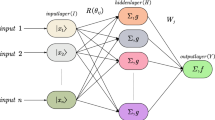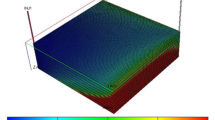Abstract
Formation damage associated with aqueous phase trapping (APT) often occurs during drilling wells using water-based fluids in tight reservoirs. Prediction of a reservoir’s APT severity is of great importance, since well productivity can be improved through proper prediction and consequent attempts to reduce formation damage. In this paper, the mechanism for APT occurrence is analyzed. Different factors affecting APT are evaluated and selected to develop a neuron network model for APT prediction, which is based on the information processing method of biological neurons and quantum neural algorithm. The model proposed in this paper is quantum neural network (QNNs) model, which is considered to have an advantage over previous models in terms of the internal algorithm. The model can be used to predict the severity of APT in tight sandstone formations quantitatively. This model has been applied in one pilot area in Jinlin oilfield, China. The results show very good accuracy in comparison with the experimental data.







Similar content being viewed by others
Abbreviations
- \(S_{\text{wi}}\) :
-
Initial water saturation (fraction)
- \(S_{\text{wirr}}\) :
-
Irreducible water saturation (fraction)
- \(K_{{{\text{rg}}\hbox{max} }}\) :
-
Maximum gas reservoir relative permeability (mD)
- \(K_{{{\text{rw}}\hbox{max} }}\) :
-
Maximum water reservoir relative permeability (mD)
- \(K_{\text{a}}\) :
-
Air permeability (mD)
- \(\sigma\) :
-
Oil/water interfacial tension (mn/m)
- \(\phi\) :
-
Porosity, fraction
- \(d_{\text{p}}\) :
-
Average pore diameter (µm)
- ANN:
-
Artificial neural networks
- APT:
-
Aqueous phase trapping
- QNN:
-
Quantum neural network
- GRA:
-
Grey relational analysis
References
Bahrami H, Rezaee R, Saeedi A, Murikhan G (2012) Phase trapping damage in use of water-based and oil-based drilling fluids in tight gas reservoirs. Soc Petroleum Eng. doi:10.2118/154648-MS
Bai MX (2014) Risk assessment for CO2 Leakage along abandoned wells using a monte Carlo simulation in a CO2 sequestration site. J Pet Sci Technol 32:1191–1200
Bai MX, Sun YX, Patil PA, Reinicke KM (2012) Prediction of formation water sensitivity using multiple linear regression and artificial neural network. Oil Gas Eur Mag 38(3):132–137
Bai MX, Reinicke KM, Song KP, Li Y, Sun JP (2014) Relative permeability model and CO2 leakage through abandoned wells during CO2 underground storage. Oil Gas-Euro Magazine 40:161–165
Bennion DB, Thomas FB, Bietz RF, Bennion DW (1996) Water and hydrocarbon phase trapping in porous media-diagnosis, prevention and treatment. J Can Petrol Technol 35(10):29–36
Bennion DB, Thomas FB, Imer D, Ma T (2000) Low permeability gas reservoirs and formation damage -tricks and traps. In: Proceedings of SPE/CERI Gas Technology Symposium, Calgary, Alberta Canada
Bluman AG (2011) Elementary statistics: a step by step approach, eighth edn. McGraw-Hill Education
Civan F (2014) Analyses of processes, mechanisms, and preventive measures of shale-gas reservoir fluid, completion, and formation damage. Soc Petroleum Eng. doi:10.2118/168164-MS
Coskuner G (2004) Drilling induced formation damage of horizontal wells in tight gas reservoirs. J Can Petrol Technol 43(11):13–18
Davis BBJ, Wood WD (2004) Maximizing economic return by minimizing or preventing aqueous phase trapping during completion and stimulation operations. Soc Petroleum Eng. doi:10.2118/90170-MS
Fletcher P, Coveney P (1995) Prediction of thickening times of oil field cements using artificial neural networks and fourier transform infrared spectroscopy. Adv Cem Based Mater 2(1):21–29
Foroutan S, Moghadasi J (2013) A neural network approach to predict formation damage due to calcium sulphate precipitation. Soc Petroleum Eng. doi:10.2118/165157-MS
Gupta DVS (2009) Unconventional fracturing fluids for tight gas reservoirs. Soc Petroleum Eng. doi:10.2118/119424-MS
Hecht-Nielsen R (1989) Theory of the backpropagation neural network. In: International joint conference on neural networks, Washington
Kalam MZ, Al-Alawi SM, & Al-Mukheini M (1996) Assessment of formation damage using artificial neural networks. SPE Formation Damage Control Symposium, Lafayette
Li P, Tan TC, Lee JY (1997) Grey relational analysis of amine inhibition of mild steel corrosion in acids. Corrosion 53(3):186–194
Li PC, Wang HY, Yang Y (2012) Oilfield water-flooded layer identification method based on quantum neural networks. Comp Appl Software 29(5):41–43
Mirzaei PA, Moghadasi J, Masihi M (2010) Formation damage through aqueous phase trapping in gas reservoirs. In: SPE Deep Gas Conference and Exihibition. Manama, Bahrain
Pellizzari L, Neumann D, Alawi M, Voigt D, Norden B, Würdemann H (2013) The use of tracers to assess drill-mud penetration depth into sandstone cores during deep drilling: method development and application. Environ Earth Sci 70(8):3727–3738
Pentland CH, Itsekiri E, Al-Mansoori S, Iglauer S, Bijeljic B, Blunt MJ (2010) Measurement of nonwetting-phase trapping in sandpacks. Soc Petroleum Eng. doi:10.2118/115697-PA
Rezaian A, Kordestany A, Sefat MH (2010) An artificial neural network approach to formation damage prediction due to asphaltene deposition. Soc Petroleum Eng. doi:10.2118/140683-MS
Riedl J, Rotter S, Faetsch S, Schmitt-Jansen M, Altenburger R (2013) Proposal for applying a component-based mixture approach for ecotoxicological assessment of fracturing fluids. Environ Earth Sci 70(8):3907–3920
Sun YX, Xiao C, Zhao JY (2011a) New method for predicating reservoir sensitivity rapidly. In: Proceedings of International Conference on Machine Learning and Cybernetics. Guilin, Guangxi, China
Sun YX, Zhao FL, Zhang K (2011b) The application of grey relevancy predict water blocking in Gu Longnan area of Daqing. In: 6th IEEE Joint International Information Technology and Artificial Intelligence Conference. Chongqing, China
Sun YX, Xiao C, Lang YS. (2011c) Predicating reservoir sensitivity rapidly with single –correlation analysis and multiple regression. In: 6th IEEE Joint International Information Technology and Artificial Intelligence Conference. Chongqing, China
Toth G, Lent CS, Tougaw PD, Brazhnik Y, Weng W, Porod W, Liu RW, Huang YF (1996) Quantum cellular neural networks. Superlattice Microstruct 20(4):473–478
You LJ, Kang YL (2009) Integrated evaluation of water phase trapping damage potential in tight gas reservoirs. In: SPE European Formation Damage Conference. Scheveningen, Netherlands
Zuluaga E, Alvarez HD, Alvarez JD (2002) Prediction of permeability reduction by external particle invasion using artificial neural networks and fuzzy models. J Can Petrol Technol 41(6):19–24
Acknowledgments
The authors would like to thank Jilin Oilfield Drilling Technology Institute for providing data and field tests. This work is financially supported by Graduate Education Innovation Project in Heilongjiang Prince (Project Grant No.: JGXM_HLJ_2014027), and Scientific Research Fund of Heilongjiang Provincial Education Department (Grant No.12521045).
Author information
Authors and Affiliations
Corresponding author
Rights and permissions
About this article
Cite this article
Sun, Y., Zhao, J. & Bai, M. Predicting aqueous phase trapping damage in tight reservoirs using quantum neural networks. Environ Earth Sci 73, 5815–5823 (2015). https://doi.org/10.1007/s12665-015-4247-4
Received:
Accepted:
Published:
Issue Date:
DOI: https://doi.org/10.1007/s12665-015-4247-4




